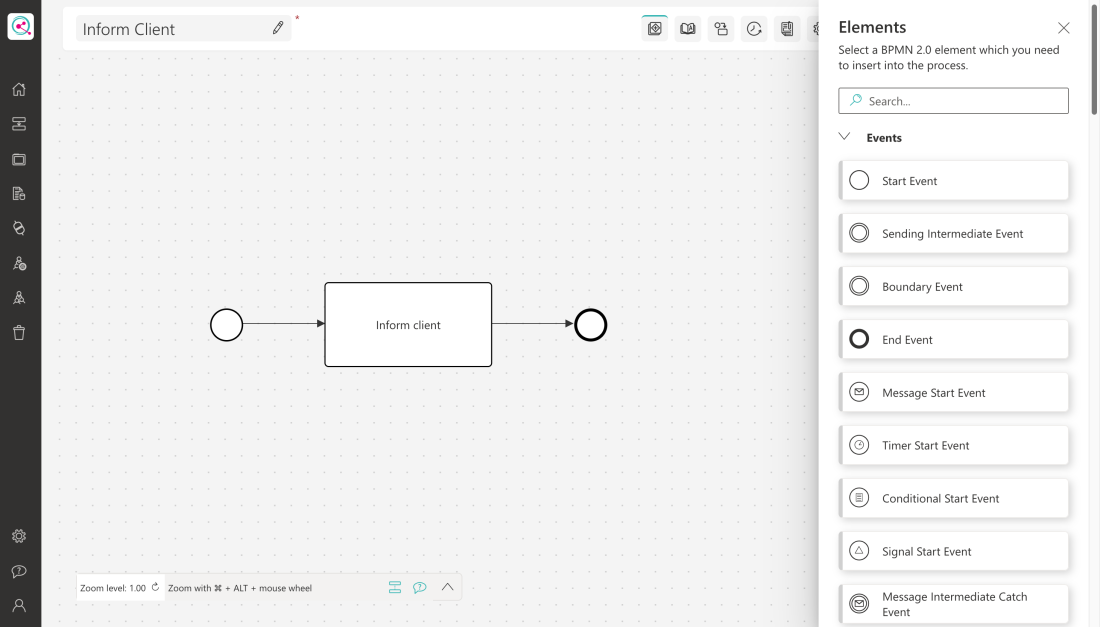Lorem ipsum dolor sit amet, consectetuer adipiscing elit. Aenean commodo ligula eget dolor. Aenean massa. Cum sociis natoque penatibus et magnis dis parturient montes, nascetur ridiculus mus. Donec quam felis, ultricies nec, pellentesque eu, pretium quis, sem.
Contents
BPMN (Business Process Model and Notation) is the global standard for the graphical representation of business processes. BPMN is used in numerous industries, including IT, finance, manufacturing and healthcare. BPMN is particularly well represented in the insurance industry and the service sector.
The aim of BPMN is to map business processes in a clear, concise and standardized way – regardless of industry or tool. Companies use BPMN to analyze and optimize processes or as a template for digital workflows. However, although BPMN is the basis for a structured process description, the benefits often stop at modeling. The transition to automated processes from BPMN has many challenges. It only takes a few clicks to automate BPMN. Find out how easy it can be.
The challenges of BPMN automation
One of the biggest advantages of BPMN is also one of the biggest disadvantages for automation. BPMN models mainly describe what should happen, but not how it happens or is implemented. For the actual execution of a BPMN process, the level of detail in the description is lacking. For example, there is the “Notify customer” action. However, it remains completely open how the notification takes place and with which technical programs. Is an e-mail sent, is the customer informed personally by telephone? Where does the e-mail come from? What happens if the customer does not answer the phone call?

The linqi automation platform makes the transition from automated processes to BPMN or from BPMN modeling to automated processes. Experience how easy it can be to transform your existing BPMN processes into automated processes.
linqi as an automation platform
The linqi automation platform creates the bridge between BPMN modeling and real processes. Within the platform, processes can be implemented in their own representation with the appropriate level of detail for automation and BPMN modeling can also be created. With just one click, BPMN can be converted into executable processes that can then be used for further work. Fully automated processes can also be converted directly into BPMN processes.
Experience how easy it can be to automate BPMN modeling.
In doing so, linqi interprets your BPMN models and creates the relevant actions for you, such as sending emails in the automated process. You can also define additional rules that apply when creating a process from BPMN. Accelerate digitalization in your organization and avoid duplication of work.
5 steps from BPMN model to automated process
- Import BPMN as a .bpmn file into the linqi platform.
- In the linqi Process Designer, click on “Generate process from BPMN 2.0”
- Fill in the generated actions with a few details and add forms.
- Test your process.
- Publish your generated process from BPMN 2.0.
Processes that have already been defined can be digitally mapped in our platform with just a few clicks. This has the advantage that you can now work without media disruptions, with documentation and process execution taking place on one platform.
Frequently asked questions on BPMN automation
What is the difference between a BPMN model and an automated process?+-
A BPMN model describes the flow of a process on an abstract level (what should happen). An automated process, on the other hand, contains the concrete technical implementation. For example, how the steps are executed, e.g. through APIs, scripts or systems.
Why can't BPMN models be executed directly?+-
BPMN is first and foremost a communication tool. It does not define any technical logic, data flows or specific system integrations. These gaps must first be closed before a process can be automated.
How does linqi help to automate BPMN models?+-
linqi interprets BPMN models and converts them into executable processes. Tasks, decisions and events are linked to technical actions, e.g. API calls, notifications or database queries.
Which BPMN elements does linqi support during conversion?+-
linqi supports all common BPMN elements such as tasks, gateways, events, sub-processes and more. More complex structures such as loops or event-based gateways can also be automated.
Do I have to model my BPMN models specifically for linqi?+-
No, linqi works according to the BPMN 2.0 standard and can import and automate all exports from common modeling tools if they comply with the BPMN 2.0 standard.
What are typical use cases for BPMN automation with linqi?+-
Examples include onboarding processes, approval workflows, ticket processing, contract reviews or automated customer communication – wherever clearly structured processes need to be digitized.
Request a free live demo
After a preliminary discussion of approx. 30 minutes, we will automate your process free of charge and demonstrate linqi to you using your own process in a live demo via video call (approx. 60 minutes) to clarify any open questions.
Request Live-Demo
